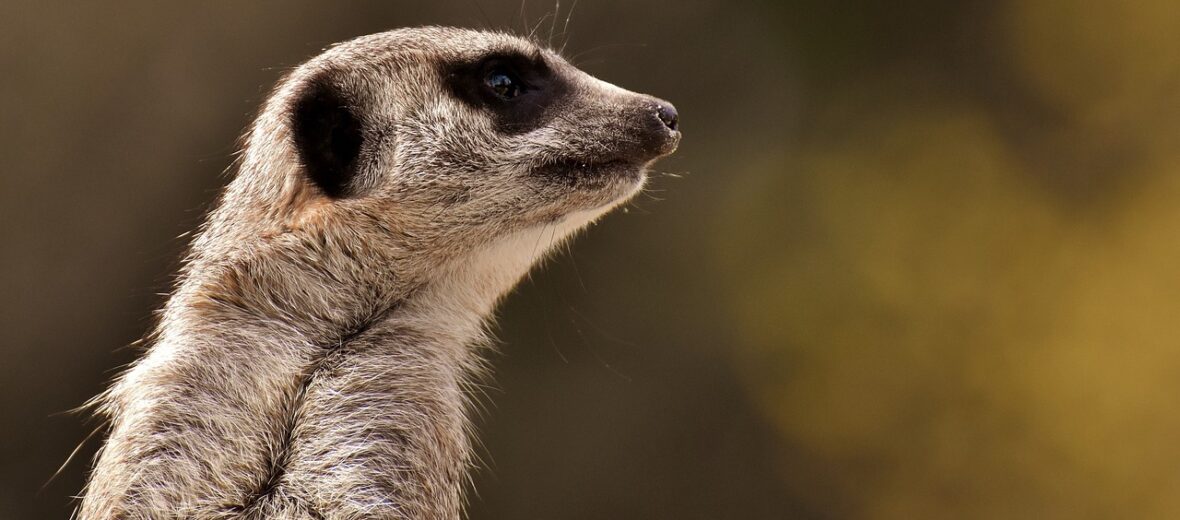
The meerkat belongs to the mongoose family. Nope, they aren’t cats at all. They live in semi-arid and arid deserts in western and southern Namibia, southwestern Botswana, and north and west South Africa. While they don’t sing songs about life or make friends with warthogs or especially lions, they are sociable with each other. These cute critters can be seen in large groups, called mobs or gangs, of up to 40+ individuals. Due to their stable numbers, meerkats are listed as Least Concern by the IUCN.
First the Stats…
Scientific name: Suricata suricatta
Weight: Up to 1.6 lbs.
Length: Up to 14 inches, plus a 9.8 inch tail
Lifespan: Up to 14 years
Now on to the Facts!
1.) Mobs consist of about 2 – 3 families and these families share a single burrow network.
2.) Meerkat burrows have up to 15 entrances/exits. They can also be up to 6.5 feet deep.
3.) They may all sound alike but meerkats can actually recognize each other’s voices.
4.) While they socially groom, play, and hunt, someone is always on the lookout.
5.) While the group is out hunting, one adult or sub-adult will babysit the pups till the hunting party returns.
But wait, there’s more on the meerkat!
6.) The older meerkats teach the younger one how to hunt by progressively bringing more and more difficult prey to them and allowing them to learn to experiment on how to catch and kill prey.
7.) A dominant male and female rule the mob. However, ultimately, it’s the alpha female that rules the roost. And if a subordinate female gives birth, the alpha female will banish or even kill the newborn pup(s).
Did you know…?
Believe it or not, meerkats are almost totally immune to a wide variety of venom from scorpions and snakes.
8.) When traversing new terrain, the alpha female makes the subordinates take the lead and risk while exploring the uncharted territory, while she sits back in safety. It’s good to be the queen.
9.) Meerkats eat small lizards, insects, scorpions, snakes, eggs, roots, and bulbs. This makes them omnivores (eat plant and animal matter).
10.) Their bellies are nearly bald. After spending the night in a cold burrow, meerkats will emerge and stand tall, exposing their black belly skin in order to warm themselves up.
But wait, there’s still more on the meerkat!
11.) The fork-tailed drongo is a bird that mimics the warning calls of meerkats. After they have noticed a meerkat mob taking some tasty prey, the drongo will make the alert call, causing the gang to scatter, abandoning their kill so the bird can get a free meal. Cheater!
Did you know…?
Gang wars are commonplace amongst meerkat families. They may be affectionate and protective of those in their own clan, but they will fight to the death any outside family that tries to take over their territory.
12.) They have evolved a dark coloration around their eyes to help keep the sun’s glare down.
13.) These durable little critters are quite drought resistant and get all the water they need from the food they eat.
14.) Their main predators are snakes, jackals, and birds of prey.
15.) The cries of pups tends to not go unnoticed. It was been witnessed and tested that when pups make a certain set of cries, it causes the adults to give up their food to the little ones.
Now a Short Meerkat Video!
Here’s Another Short Meerkat Video!
Also, check out the Critter Science YouTube channel. Videos added frequently!
Want to suggest a critter for me to write about? Let me know here.




Leave a Reply